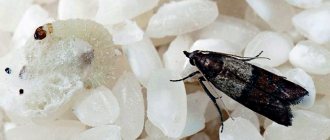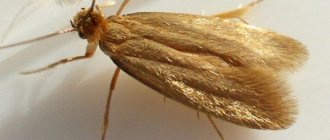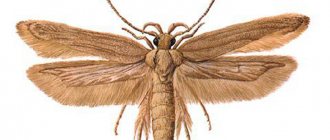Unexpected “guests” appear in every kitchen from time to time. Having opened a bag of cereals, you may find to your displeasure that small bugs or white caterpillars have settled in it. This is a food moth. Despite its small size, the insect can cause a lot of trouble to humans. At first glance, there’s nothing wrong with it - they threw away the contaminated product and that’s it. In fact, fighting this pest turns out to be quite difficult. It starts even in those kitchens where exemplary order reigns. So the opinion that only bad housewives get moths in their cereals is completely unfair. We’ll talk to you today about how to get rid of an uninvited guest.
You need to know the enemy by sight
What does food moth look like? This is an inconspicuous butterfly about one centimeter in size. Her wings can be light gray or brown. If you see such a creature circling around the kitchen, then you urgently need to check all your supplies.
An adult insect is not dangerous because it does not eat anything. However, water is necessary, so you can often find a butterfly next to the kitchen sink. She lives for about two weeks. And everything would be fine, but during this time the insect is capable of laying up to 400 eggs in hard-to-reach places, behind kitchen furniture.
After 10-15 days, many larvae will hatch from them and set off to conquer the vastness of your kitchen. There are different types of these pests: barn moth, cereal moth, nut moth, and miller moth. But they are all highly gluttonous. If you notice a butterfly in the kitchen, then you will definitely find a moth in the cereal. We will consider below how to get rid of this neighborhood.
There are already moths in the cereal: what to do?
Reference. From a scientific point of view, the grain moth is a collective image. Experts identify grain moth, potato moth, barn moth, dried fruit moth, and mill moth. Only by taking this into account can you quickly find the source of reproduction.
Fighting moths - a set of measures
Remedy No. 1 Garlic
If you ask any grandmother how to get rid of grain moths, she will name garlic as one of the surest remedies. Yes, indeed, this insect cannot tolerate the smell of garlic, so it’s worth opening the teeth slightly and putting it on drawers and shelves. In theory, the moth should be frightened by the specific aroma and leave their favorite places. True, it should be noted that modern moths have the ability to adapt to such conditions, so ignoring this smell does not go away.
Remedy No. 2 Vinegar
An alcohol solution of acetic acid has been used for hundreds of years as an effective means of combating moths. The vinegar smell really repels insects. Treatment with this product follows the following formula: washing the kitchen with soapy water + treating corners, crevices and surfaces where moths usually hide + blocking the kitchen area for several hours + airing.
Remedy No. 3 Bay leaf/clove/basil
As an option to answer the question: moths in cereals - how to get rid of it, it is proposed to lay out bags of the following in different places of the kitchen set:
- bay leaf;
- rosemary;
- wild rosemary;
- tansy;
- fir
As an option, you can lubricate the “risk zones” with aromatic oils created on the basis of the above-mentioned plants. This will also repel grain moths.
Moths do not like it when cabinets are treated with products that smell like lavender, geranium, rosemary, etc.
Remedy No. 4 Lavender
The queen of the mountains, lavender, has long been considered an excellent “weapon” against insects. Its seed is wrapped in gauze and placed in the right places, or cotton swabs soaked in lavender oil are laid out.
Remedy No. 5 Citrus
This does not mean the fruit itself, but the orange, tangerine or lemon peel. It is also laid out in cabinets. The fragrant crusts emit an odor pleasant to humans and destructive to moths. As soon as its intensity decreases, the peel must be replaced with fresh one.
Remedy No. 6 Geranium
It turns out that our grandmothers had geraniums (kalachik) occupying all the window sills not only for the sake of beauty. Many insects, including moths, cannot stand its smell. In a modern interpretation, the use of aromatic oil with this smell is allowed. It is applied to cotton swabs and placed in different parts of the kitchen.
Remedy No. 7 Walnut leaves
It is worth using another folk remedy, the effectiveness of which has been repeatedly tested in practice - walnut tree leaves. This means a regular walnut. Freshly picked leaves are used - their smell drives away moths for a long time.
Remedy No. 8 Calcination
There are moths in the cereal - can it be heated? Yes, this method is one of the options for combating a harmful parasite. True, it’s worth doing this if the cereal is only slightly infected. In this case, you need to fry the cereal and remove the resulting lumps.
It is better to store cereals in the oven after piercing - moths do not like such an environment
Remedy No. 9 Aerosols
The modern market is rich in various aerosol anti-moth products. This is a radical method that requires some effort and time. Dishes are taken out of the kitchen, contaminated food is thrown into the trash, and everything else (cabinets, countertops, tiles, etc.) is sprayed with a special agent. Tablecloths, curtains and other fabric accessories are washed at 90 degrees. All storage containers are washed in a soda solution.
Remedy No. 10 Traps
The use of special traps is also an effective way to combat moths. True, they are not able to completely rid the kitchen of this insect, but they will reduce the population. The consumer chooses them for ease of use. The secret to the functioning of such products is simple: the paper tape is impregnated with an adhesive composition that includes pheromones from adult female moths. The insects flock to this smell, sticking to the tape.
Please note that moths do not really like buckwheat. Even if it is stored in a store bag, this insect rarely touches it. The same applies to polished rice, dried fruits including prunes, and dried peas.
Source
What does the pest eat?
This question worries many housewives, as it is the key to answering which products need special attention. Most often, moths are found in cereals and flour, dry food. This could be nuts and chocolate, dried fruits, tea and spices. Even animal food is quite suitable as a breeding ground for voracious caterpillars. But most often moths appear in cereals. We’ll talk about how to get rid of it now, but for now let’s decide how this insect gets into the house.
Routes of infection
The best solution to a problem is its prevention. This is an indisputable fact, which is why it is important to know where moths in cereals come from. How to get rid of an insect is the second question; it is better not to allow it into your home at all. Unfortunately, this is more difficult to accomplish than it seems at first glance. The fact is that many food products become contaminated during production. This occurs due to improper processing, violation of storage standards, etc. In the warehouse and store, temperature conditions may be unsuitable for the development of larvae, so they are waiting in the wings.
At home, we usually store dry food in closed cabinets. It is dark and warm there - ideal conditions for insects to begin actively breeding. The population is increasing sharply. The larvae chew through the bags and infect everything within reach. Sometimes moths can arrive from neighbors, but this happens extremely rarely. Therefore, you should not think badly about the people who live nearby. Now you know where moths in cereals come from. We still have to figure out how to get rid of it.
How to get rid of moths in the kitchen?
To remove moths from the kitchen you will need an integrated approach - destruction and preventive measures.
Let's see what you need to pay attention to first.
Product Check
Since the larvae of this small butterfly are found in the products themselves, and then pupate while in your cupboard, first inspect all the cereals, check pasta, sugar, nuts, flour, dried fruits. Think, perhaps there are some spoiled foods that need to be thrown away - you need to look for moths in them first.
Preventive action
Pay attention to these simple rules:
- You should not purchase products in very large quantities. Kitchen moths multiply very quickly and before you have time to “blink an eye”, large stocks of food will all be contaminated and there’s nothing you can do about it - you’ll have to throw everything away.
- Be sure to inspect cereals and other products when purchasing. Nowadays a lot of things are sold in transparent packages and this will not be so difficult. When examining, remember the main signs of moths - even if you only notice a web, it is better to immediately refuse the purchase.
- Give preference to more reliable brands. They may be more expensive, but you will be more confident that heat treatment was carried out and the manufacturer did not skimp on this in order to make the price more affordable in the future.
- Regularly organize a “clean day” for your kitchen cabinets, balconies, and pantries. If you see that cereal has scattered somewhere, be sure to remove everything and wipe it clean.
- Also check the herb packets. Some people may keep them for a long time, so inspect all old stock.
Here are some more effective remedies for moths in the kitchen.
- Moths do not like garlic and citrus fruits, so it makes sense to put a clove of garlic in each jar and the peel of any citrus fruit in the cabinet.
- Ventilate the room often—moths don’t like fresh air either.
- Store food in ceramic or glass containers that moths cannot chew through, so it will be more difficult for them to get to the “new” grain.
- Moths do not like the smell of herbs such as cloves, mint and lavender. Therefore, bags or sponges soaked in essential oils of these herbs in the cabinets will bring not only a pleasant aroma to your kitchen, but also get rid of the pest.
Product Rescue
If during your inspection you find products that have not yet been seriously affected by moths and you feel sorry to throw them away, then you can try to save them. To do this, you will need to sort through (for example, cereals or pasta) and get rid of the cocoons. After this procedure, carry out heat treatment - heat the product in the microwave for about 15 minutes, setting the temperature to 60-70. Of course, this method may not be suitable for all products, but for dry bulk products it will be a salvation.
Room treatment
For treatment, it is recommended to wipe all surfaces inside and out with a soap or vinegar solution. When you wash, be sure to wipe all the cracks - cocoons can “linger” there. Afterwards, leave the cabinet doors slightly open to allow everything to dry thoroughly. Do not forget also about the existence of pheromone traps - they will attract male moths
However, with this method, care must be taken not to accidentally attract moths from a neighbor through an open window. The smell is quite strong and will last for several days
Follow these simple rules and soon the question of how to get rid of kitchen moths will no longer bother you.
This is what a moth looks like in a sealed package:
Is it possible to eat contaminated foods?
Absolutely not. If you notice that a butterfly is flying around the apartment, it means that there are its offspring somewhere. It needs to be found and thrown away along with the cereal in which it was hatched. The sooner you do this, the greater the chance that the rest of the food will remain intact. Moth larvae gnaw through the bags and greedily eat the contents. But it's not only that. At the same time, the caterpillars infect them with waste, feces, shed skin and dead larvae. Experts recommend not to take risks and throw away such products without any regret.
Adults are less dangerous, but are also annoying with their presence. They flash before your eyes, sit on food and drown in vases of jam. However, the most important thing is that these annoying creatures lay hundreds of eggs and give birth to new hordes of hungry caterpillars.
Let's start the fight
So, moths were found in cereals. Now we’ll figure out how to get rid of the pest. This will require a whole range of measures that together will help restore cleanliness:
- Full inspection and refurbishment. If a cereal pest was found in the kitchen, you will have to get serious about cleaning. Open all the cabinets, take out food from the most hidden shelves. This is a chance to kill three birds with one stone: do general cleaning, check expiration dates and find moths in cereals. How to get rid of it (see photo in our article) in the shortest possible time? Throw away any spoiled food in which larvae are found.
- Doubts are raised by those packages of cereals that at first glance look uncontaminated, but were stored unsealed. In this case, it is better to throw them away too. They may contain insect eggs that you cannot see with the naked eye.
- Now, since the food has left its place anyway, you can sanitize the kitchen. All remaining cereals must be packed again into hermetically sealed containers, and cabinets and shelves must be washed. After such cleaning, entering the kitchen is a pleasure.
Treating kitchen furniture against food moths
Such an event is simply necessary to destroy the larvae. After all, before the pupation process, they leave the food and spread throughout the entire territory. They can be found on walls, furniture doors and so on. For treatment, you can use various aerosols and means to kill ants and cockroaches. Today you can buy special products specifically against food moths and their larvae. Before treating furniture with chemicals and some time after, carry out wet cleaning.
After poisoning once, you should not hope that the insect will disappear. The emergence of larvae from food occurs at different times, and they can reappear in the kitchen within a couple of days. There are drugs that have a prolonged effect. They last much longer, but can be used exclusively for furniture, avoiding contact with products.
In the photo - food moth larvae
The use of chemicals alone will not have an effect unless a targeted fight is organized and the damaged products are not disposed of.
The best hygiene products
What do you use if there are moths in the cereal? How to get rid of this uninvited guest with maximum effect and in a short time? Experts recommend washing all surfaces with soap and vinegar solutions. However, not just any soap will do. Set the scented toilette aside. The ideal choice would be an alkaline household cleaner, which has mild insecticidal and disinfecting properties. That is, you can additionally prevent the appearance of fungus.
Preparing a soap solution is not difficult. Take three liters of warm water and dissolve the cob in it until the water becomes noticeably soapy. All surfaces must be thoroughly rinsed with this mixture and then treated with clean water. After complete drying, you can put the products in their places.
Vinegar solution
Each housewife has her own recipes that she uses if moths appear in cereals. How to get rid (reviews emphasize that this method works flawlessly) from insects if the soap solution did not cope with its task? Housewives agree that this is only the first stage of processing. To be completely sure of effectiveness, after the shelves have dried, you need to wipe them with a cloth moistened with 5% or 9% vinegar. Now you can count on your cabinets being completely free of larvae and eggs.
The experience of our grandmothers
Remember how you visited the village as a child. Grandma’s cereal cupboard always smelled absolutely amazing and pleasant. The fact is that they knew very well that if there were moths in the cereals, then the food would have to be thrown away, and being practical people, they did not want to allow such waste. Therefore, we widely used the means that nature gives us.
Lavender and mint, black pepper and garlic are good at repelling moths. Citrus fruits and tobacco cope well with these responsibilities. Therefore, feel free to put orange and tangerine skins and cloves of garlic in your cabinets. Flour and grains do not absorb odors, so your dishes will be flawless.
Traditional methods
How to get rid of moths in cereals using improvised means? The use of bay leaves is very popular. They should be placed on all shelves, and food moths in the kitchen will quickly disappear, since the plants have a repellent odor.
Pests do not like the aroma of essential oils. To repel insects, you can use fir, lavender and any other similar product that has a pronounced odor. Oil should be used to wipe all surfaces in cabinets, countertops and other surfaces. To enhance the effect of the esters, it is necessary to leave dry lavender in places where the largest concentration of pests was found. Tobacco has a similar effect, so it can also be placed on kitchen shelves.
An effective remedy for food moths is a special trap. To prepare it, you need to mix 3 parts flour with 1 part boric acid. Place the resulting mass in a small open container and place on a shelf. It is advisable to prepare several similar baits at the same time in order to get rid of fruit moths as quickly as possible. This remedy acts not only on adults, but also on developing parasites.
Ammonia has a similar effect. To prepare a working solution from 1 liter. water and 1 tbsp. l. ammonia. Soak a rag in the liquid and thoroughly wipe all cabinets, including the top and side walls. The product has a strong odor, which has a pronounced deterrent effect on pests.
A fragrant and effective method of combating fruit moths is lemon or orange peel. The smell of dry citrus fruits has a detrimental effect on parasites. To achieve an insecticidal effect, the crusts must be placed on all shelves. Geranium, wormwood and garlic have a similar effect. They can be used fresh or dried. The garlic must first be peeled, this will provide a more pronounced smell.
Once you get rid of food moths, there is no need to relax. No one can guarantee that after some time it will not appear again, because most often parasites enter a person’s home along with low-quality products.
To avoid this, every effort should be made. Cereals and other bulk products must be kept in glass containers and not in plastic bags or factory packaging. This will help maintain tightness, and even if there is a single pest in the cereal, it will not be able to increase in number and fill the entire space.
Chemistry in your home
When talking about what to do if moths have appeared in cereals, many immediately imagine going to the store and choosing an insecticide. In fact, their use in the kitchen is extremely undesirable, as it can result in poisoning. Therefore, it is better to focus on safe means that remove moths mechanically. These are sticky tapes. They are treated with a special substance that attracts moths. They are usually hung in the corners of food storage cabinets.
If you want a quick effect, then buy Raid aerosol. It is very toxic, so use must be extremely careful. Remove flowers, an aquarium, and all dishes from the room. Take family members and pets outside. After this, you can treat the room and ventilate well.
Food moths in an apartment - is it possible to get rid of them at home?
Thanks to modern industrial means, removing annoying midges from the kitchen will not be difficult. To combat the parasite, you can use both aggressive chemicals and traditional methods.
Most housewives prefer the first option, but it is worth considering that such products contain dangerous components that are undesirable to come into contact with the working surfaces of the headset and products. Traditional methods are safer and more delicate. Their only drawback is that it will take more time to fight the parasite.
In any case, in order for breeding food moths in the kitchen to be successful, you need to adhere to the following principles:
- it is necessary to completely eliminate the affected products, since they may contain larvae;
- every flying parasite must be destroyed;
- The chosen product requires treating all surfaces of the kitchen unit and other furniture located in the room. Additionally, skirting boards, chandeliers, and cornices are treated.
Elimination of the parasite requires compliance with a set of different measures. It is worth considering that it is unlikely to be possible to remove it with one action.
Important! Food moths are resistant to many insecticides, so the fight against them can be lengthy.
Storage tips
It used to be that plastic bags were impenetrable to moth larvae. However, it is not. She quite easily chews through the material and spoils the food. Therefore, the ideal storage option is canvas bags with good ties. However, it is even more convenient to pour the cereals into plastic or glass containers with tight-fitting lids. If you use our tips, you will most likely be able to avoid pests from appearing in your kitchen. Now you know what to do if there are moths in cereals.
Prevention of occurrence
What to do to prevent a moth invasion? Observe the following rules:
- isolate external communications with nets: windows and ventilation grilles. Do not leave balcony doors open - moths often fly towards artificial lighting at night;
- carefully inspect the cereals before purchasing;
- if there is an urgent need to make large reserves, fry the cereals in the oven or microwave, but, in general, shelves bursting with food are the prerogative of supermarkets;
- store cereals in airtight containers;
- make it a rule to do regular audits of your products;
- Wet cleaning and ventilation of the apartment should not be neglected;
- use repellents: the same lavender on the windowsill will not only decorate the apartment, but will also repel moths.
You don’t need to think that a moth is something distant. Very often it can be found in a completely unpredictable place. Despite the control, even in stores she is not a rare guest. If vacuum packaging somehow guarantees the absence of moths, then by weight the chances of getting an unexpected parasite increase. Therefore, prevention and regular cleaning are the only things that will definitely protect you from the invasion of this pest.











